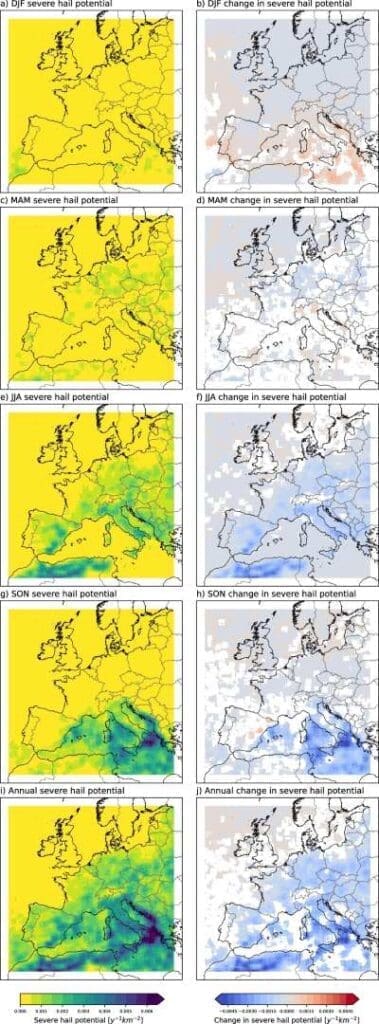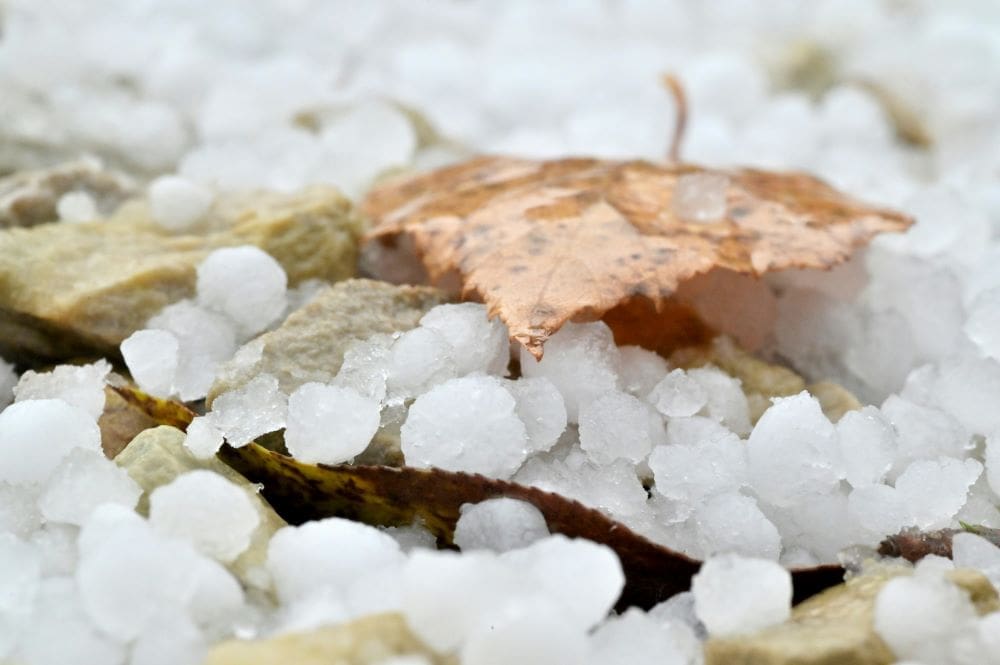Summary:
Climate change could make Europe’s hailstorms less frequent but more destructive, according to new research published in Nature Communications. Scientists from Newcastle University, the Met Office, and the University of Bristol used pan-European, high-resolution climate simulations to model how hail formation might change under a high-emissions scenario (RCP8.5).
The study found that while the potential for severe hail – with a diameter of at least 2 cm – decreases in a warmer climate, the likelihood of very large hail, 5 cm or more in diameter, could rise in parts of southern Europe. The researchers attribute the overall decline to hail forming at higher altitudes in a warmer atmosphere, where weaker updrafts and greater melting reduce its chance of reaching the ground. However, future warm seasons may bring thunderstorm conditions resembling those in the tropics, where the largest hailstones can still reach the surface. These storms are projected to occur most often over southern Europe, potentially leading to more intense regional hail events.
The findings suggest that, although hailstorms may become less common, their impact could grow, as larger hailstones are capable of causing far greater damage to crops, property, and infrastructure.
Climate change is supercharging Europe’s biggest hail
Climate experts from Newcastle University, the Met Office and the University of Bristol used European-wide km-scale simulations to model future changes to hail with global warming. The findings show that, under a high-emissions scenario (RCP8.5), severe hail is likely to become less common, except potentially for very large hail.
Severe hail has a diameter of 2 cm, while a diameter of 5 cm or more is considered very large. Bigger hailstones cause more damage than smaller ones, and even a small increase in their size could outweigh any benefits from having fewer hailstorms overall.

The researchers attribute this decrease to more than one factor. Hail forms higher in the atmosphere as it warms, where storm updrafts could be weaker, and this gives hail more time to melt before reaching the ground. Another factor is the weakening large scale circulation, affecting the vertical profile of winds and leading to environments not beneficial for thunderstorm organization.
Importantly, the authors found that future warm seasons feature a warmer thunderstorm type similar to hail-producing storms found in the tropics, where the largest hailstones can still reach the surface. The findings suggest that, in the future, these storms will become most frequent over southern Europe, leading to regional increases in severe hail frequency.
Study lead author, Dr Abdullah Kahraman, Senior Researcher in Severe Weather and Climate Change, School of Engineering, Newcastle University and long-term Visiting Scientist at Climate Processes and Projections (CPP), Met Office Hadley Centre, said: “Our findings indicate that the effects of climate change on severe thunderstorms are more complex than previously thought, and high-resolution models can produce results that differ significantly from earlier research. Society may need to prepare for less frequent, yet more damaging hail events locally, in a 5-degree warmer future.”
Professor Lizzie Kendon, Head of Climate Projections at the UK Met Office and Professor of Climate Science at the University of Bristol, noted: “These results are very concerning. They imply we need to be prepared for tropical-type hailstorms impacting Europe in the future, associated with very large hailstones that can cause severe impacts. This possibility also extends to the UK, although the risk of hail here remains low into the future.”
Study co-author, Professor Hayley Fowler, Professor of Climate Change Impacts, Newcastle University School of Engineering, added: “As a society we need to be better prepared for unprecedented extreme events and this study shows that future storms in the Mediterranean could bring giant hail, with devastating impacts. Recent hailstorms have caused significant direct damage to properties and infrastructure, crops, and even aircraft!”
The team’s analysis shows that the possibility for very large hailstones decreases around Central Europe, and that it remains low over the British Isles and Northern Europe land areas. In contrast, it increases in Southern Europe in autumn and winter, balancing decreases in summer and spring.
The occurrence of warm-type thunderstorms in Southern Europe in a future warmer climate could amplify the impact of hailstorms in Italy and surrounding areas, with overall more frequent significant severe hail.
The authors acknowledge the uncertainty regarding the effect of enhanced melting associated with higher freezing levels on the largest hailstones. They recommend further studies of these warm thunderstorms to improve the understanding of their potential to produce very large and damaging hail at the surface.
Journal Reference:
Kahraman, A., Kendon, E.J., Fowler, H.J. et al., ‘Future changes in severe hail across Europe, including regional emergence of warm-type thunderstorms’, Nature Communications 16, 8438 (2025). DOI: 10.1038/s41467-025-62780-0
Article Source:
Press Release/Material by Newcastle University
Featured image credit: Andres Siimon | Unsplash




